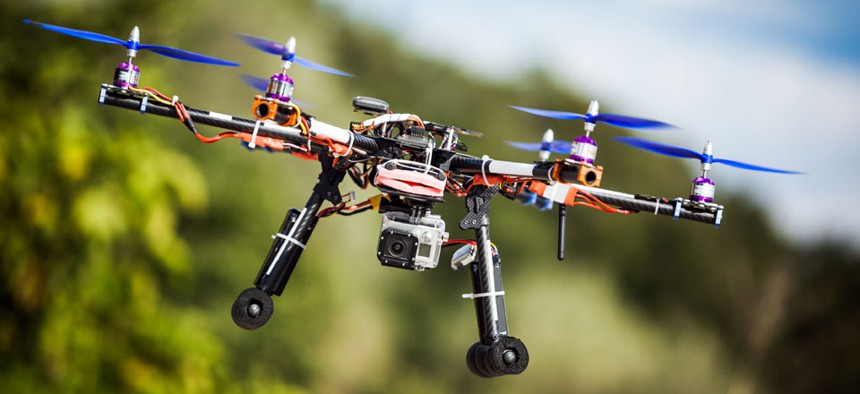Meet the Inventors, Tinkerers and Entrepreneurs Behind the Drone Revolution

funkyfrogstock/Shutterstock.com
Many enthusiasts see a future in which drones could prove as transformational—and as popular—as the personal computer.
No one knows exactly how many personal drones are buzzing through our skies, but Chris Anderson, the longtime editor of Wired magazine who now heads a drone manufacturer called 3D Robotics, estimates that at least 500,000 have been sold in the United States alone.
Though drones are fun to fly, the autopilot feature on newer models frees you up to, say, cheer at your kid’s soccer game while the drone records it from the air. On the horizon is facial-recognition software that will let drone users film themselves while catching a wave on a surfboard or navigating a mountain chute on skis. And although the Federal Aviation Administration maintains that flying drones for commercial purposes won’t be legal until next year at the earliest, drones have already proved useful in agriculture, search and rescue, architecture, and other fields. According to the Association for Unmanned Vehicle Systems International, a trade group, drones could generate more than 100,000 jobs and $82 billion in their first decade of legal commercial use.
We’ll see. The skeptics have plenty of ammunition, including serious concerns about safety—last year, a drone fell out of the sky onto a busy sidewalk in Manhattan, narrowly missing a man walking home from work, and current models aren’t equipped to avoid one another in flight.
But to drone enthusiasts—many of whom are clustered in San Diego, which has a large military-drone industry—these are just problems awaiting a technological solution. Drone manufacturing is an example of what Anderson has termed the “maker movement”: citizen inventors developing new technologies that once would have come only out of big corporations’ R&D departments. Many of these makers see a future in which drones could prove as transformational—and as popular—as the personal computer. “In developed countries, I think it will be one drone per person,” says Jordi Muñoz, Anderson’s business partner. “It’s going to reach everyone.”
The Pioneers
In 2007, when he was 19 years old, Jordi Muñoz moved from Tijuana, Mexico, to Riverside, California, to marry his girlfriend. Muñoz had always been fascinated by model aircraft, and while waiting for his green card, he did some tinkering. He stripped the motion sensors from his Nintendo Wii controllers and wired them to a GPS chip and a tiny open-source computer. The result was an autopilot system that could turn a model airplane into a drone capable of flying preprogrammed “missions.”
Muñoz described his project on a Web site called DIY Drones, which Chris Anderson had started while still at Wired . (It had only a handful of members at the time but has since grown to more than 57,000.) “Chris messaged me, asking me what I needed,” Muñoz recalls. “I told him, ‘Money!’ He sent me $500.”
Two years later, Anderson and Muñoz decided to go into business together. They called their company 3D Robotics. Among their first products was an autopilot system that Muñoz built in his garage, fixing the components in place with solder heated in a $40 toaster oven from Target. The business grew exponentially—sales have doubled every year—and by now that toaster oven seems a distant memory. 3D Robotics has a 20,000-square-foot manufacturing facility in Tijuana where more than 200 white-coated workers assemble autopilot systems and ready-to-fly drones. Revenues are expected to top $40 million in 2015.
Brandon Basso joined the company last year, after working for nearly a decade at the University of California at Berkeley’s Center for Collaborative Control of Unmanned Vehicles. He was part of a team of 20 researchers developing software and hardware that, among other things, would enable drones to fly collaborative missions (for example, two aircraft might work together to track 10 people at once) for eventual Navy use.
After so many years on the project, he’d grown a little bored: “The scope of military aircraft is quite narrow,” he says. He saw a much greater range of possible uses for personal and commercial drones.
Another issue helped induce him to leave: “The aircraft we were working with were big, and we crashed several of them at test sites—planes worth $100,000 each. It’s a really bad day when you blow up an aircraft that valuable.”
So Basso signed on as 3D’s research chief. He says the company’s latest autopilot system—Pixhawk—is nearly as sophisticated as the $10,000 systems he once programmed for the Navy. “In some ways, it’s better: it’s designed to work with a variety of aircraft.” But a Pixhawk costs $279. For a device with its capabilities, Basso says, this price would have seemed like “pure science fiction” just last year.
The Flying-Dress Maker

drone for Lady Gaga, built this custom model.
Its circular airframe is strong and dampens
vibration—helpful for aerial filming—and it
carries a high-definition Sony camcorder.
Gus Calderon had been building drones in San Diego since 2005, and by the summer of 2013, he’d earned a reputation as a maker of high-quality custom models for professional use (regardless of what the FAA says). It was then that he was asked to join a team making a “flying dress”—a drone that was both garment and aircraft—for Lady Gaga.
Though Calderon came on board in the final months, the team spent two years on the project. Gaga insisted that she be the one to try it out: she wanted to bear any risk herself. The result was Volantis, a wearable drone with 12 electric motors and carbon-fiber propellers that transported Gaga—with Calderon serving as pilot from the ground—around the Brooklyn Navy Yard during an album-release party in November 2013.
Most of Calderon’s drones cost between $2,000 and $5,000, considerably more than off-the-shelf machines from 3D Robotics and other manufacturers. But he’s aiming at a market poised to grow quickly when, as expected, the FAA eases restrictions on drones’ commercial use: filmmakers, scientists, and others who want aerial photographic surveys. For his prices, Calderon says, customers get machines capable of carrying a heavy camera, with absolute reliability and flight stability. And Calderon won’t sell them to just anyone: “If you want to buy my drones, you’re going to have to convince me you’ve got the experience to fly them safely.”
The True Believer

from an off-the-shelf kit. He added the legs,
camera, video transmitter, and other parts.
He has taught about 30 people to build a
four-arm version of this copter.
From his base at San Diego’s Fab Lab, a workspace for local inventors equipped with tools like 3-D printers and laser cutters, Chance Roth has helped develop several innovative flying robots, including the lightweight Pocket Drone, which is about to launch commercially after a Kickstarter campaign raised more than $900,000 earlier this year.
Even among drone fanatics, Roth is unusually bullish about the machines’ potential. Within five years, he predicts, drones will be able to respond to speech commands and may be able to walk your dog or keep an eye on your children while they play outside. Within 10 years, he says, drones will begin to replace manned aircraft, carrying freight and human passengers.
Having parted ways with his Pocket Drone collaborators, Roth is now working with a start-up called Brain Corporation, which aims to create drones capable of machine learning. He and his colleagues are developing models with sensors and software that will enable them to avoid obstacles in flight such as trees, buildings, power lines, and other drones. And with tracking technology, including facial recognition, Roth says, the drones will be able to track their owners from the air.
The Cameramen

forward) and Eric Maloney (hat backwards)
used off-the-shelf parts and a 3-D printer
to create the octocopter they used to film
Coldplay’s Chris Martin. In addition to doing
cinematography, they build and sell drones
like the ones they use.
On a typically perfect Los Angeles day last March, a couple of experienced and increasingly busy aerial cinematographers who call themselves the Drone Dudes were getting ready to film footage of Coldplay’s Chris Martin for use during a concert and on TV. Their other recent projects include Zach Braff’s film Wish I Was Here and commercials for Chrysler and Audi.
The Dudes—Andrew Petersen and Eric Maloney—build and fly four- and eight-propeller multicopters that weigh anywhere from three to 25 pounds, including their cameras. The care with which they prepped for the Coldplay shoot was evident. So was their stance on the FAA. “We want them to regulate us,” Maloney says. “We want nothing more than a framework to allow us to continue to operate safely and legally.”
They tested their equipment in a park, flying two big copters that beamed images down to a TV monitor. Gyrostabilized camera mounts kept the picture perfectly steady, with no sign of vibration. “There are shots you can only get with this technology,” Maloney says, “and drones are much safer for actors and crews than helicopters. The technology is changing practically every week. Soon enough, we’ll be having to replace everything.” That helps to justify the Drone Dudes’ fee: up to $7,500 a day.
( Image via funkyfrogstock / Shutterstock.com )
NEXT STORY: The Secret History of Self-Driving Cars





